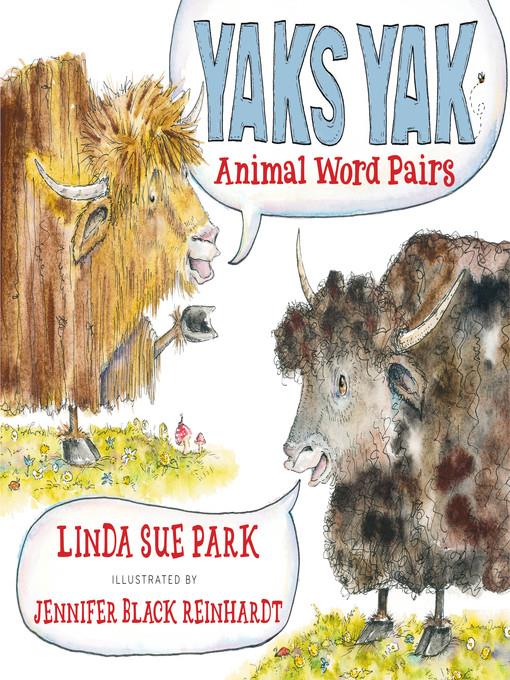
Yaks Yak
Animal Word Pairs
فرمت کتاب
ebook
تاریخ انتشار
2016
نویسنده
Jennifer Black Reinhardtناشر
HMH Booksشابک
9780544391284
کتاب های مرتبط
- اطلاعات
- نقد و بررسی
- دیدگاه کاربران
نقد و بررسی

Starred review from December 14, 2015
Perfectly pitched to its audience, this clever introduction to animal-themed homographs also works as a vocabulary lesson and a catchy read-aloud. Park (Xander’s Panda Party) and Reinhardt (The Inventor’s Secret) make an ideal team as they introduce an array of animals paired with verbs that share their names: “Cranes crane” their elongated necks in one spread, while “Slugs slug slugs” with boxing gloves. “Ack! I’m upside down! I’m upside down!” yells a floundering flounder, and one badger badgers another about the apple it’s carrying, his longwinded pleas too big to fit in the speech bubbles above his head. Things only get wilder as “bats bat” during a midair baseball game, cows drive bumper cars (“Steers steer”), and a ram accidentally rams a duck, forcing the ducks on the following page to, well, you get the idea. Succinct definitions are tucked into the illustrations (“to crow = to boast”), and back matter offers etymological notes about the animal names and verbs. Gleeful linguistic fun that kids will wolf down. Ages 4–7. Author’s agent: Ginger Knowlton, Curtis Brown. Illustrator’s agent: Marietta Zacker, Nancy Gallt Literary Agency.

December 15, 2015
Park and Reinhardt present 18 animal homograph pairs that illustrate for readers what they mean. While the text is intentionally simple to the extreme--"Bugs bug bugs"--the watercolor-and-ink illustrations slyly complete the meanings for readers. In this case, bugs of all sorts set out to annoy one another in any way possible: one beetle chucks seeds at another, a cockroach plugs the ants' hole, etc. In each double-page spread, Reinhardt unobtrusively places the definition of each word: "to bug = to annoy," though the language in these is sometimes difficult and will require adult help ("to ape = to mimic," for instance). Other animals include flounder, quail, ape, parrot, badger, slug, crane, and crow. The illustrations provide just enough details to make the meanings clear and to entertain readers--tail feathers are on prominent display on the "Duck, ducks!" page, and no child will forget the memorable "Steers steer" page, showing bovines driving bumper cars. The animals sport slightly anthropomorphized facial expressions that are easy to read. Backmatter presents a chart of the 18 words and the origins of both the animal name and the action. An excellent and entertaining vocabulary builder: pair this with Betsy Rosenthal's An Ambush of Tigers, 2015, illustrated by Jago, for more clever, educational wordplay. (Picture book. 4-10)
COPYRIGHT(2015) Kirkus Reviews, ALL RIGHTS RESERVED.

Starred review from December 1, 2015
Gr 1-4-Animal and word lovers alike will enjoy this clever take on homographs, in this case, verbs that are spelled and pronounced like animal names. Each spread features a comical illustration of animals engaged in unusual activities. A short sentence such as "Flounders flounder" or "Dogs dog dogs" appears on the verso, with a definition of the verb on the recto. Thus, yaks yak over tea, quails quail at an imposing dragon kite, bats bat baseballs in a midnight sky, and pairs of slugs slug slugs with red boxing gloves. A final spread offers a chart of the word pairs followed by the derivation of the animal's name as well as that of the action word. In some cases the verb refers to the animal's behavior, such as ape, parrot, and ram. In other cases, one seemingly has nothing to do with the other, as in quail, steer, and kid. The vibrant, amusing watercolor-and-ink illustrations introduce youngsters to some words and animals they may not know. They are occasionally enhanced with funny speech bubbles such as upside down flounders remarking, "I did not mean to do that" or relentless badgers begging an apple, "Be kind...give me the apple...you don't need...[it].... You could stand to lose a few pounds...." or greedy hogs hoarding piles of apples with signs like "MINE ALL MINE!" Other whimsical touches, such as a small fish fishing for The Book of Compliments will offer knowing readers a chuckle. VERDICT An original and fun way to build vocabulary.-Barbara Auerbach, New York City Public Schools
Copyright 2015 School Library Journal, LLC Used with permission.

February 1, 2016
Grades K-3 The English language is a curious creature, and Newbery medalist Park's (A Single Shard, 2001) delightful concept book highlights particular linguistic oddities. Yaks are not known for being particularly verbose, so why yak means to talk remains a mystery. Similarly, bats do not bat at balls, nor do slugs slug one another in a fight, though Reinhardt's comical illustrations would have us believe they could if they wanted to. But some animal-verb homograph pairs are quite reasonably matched. Bugs do indeed bug (people), hogs have a reputation of being greedy, and crows can sound like they are boasting. Every page depicts the animal enacting the verb and includes an inset box providing the definition. Details in the ink-and-watercolor illustrations, like a fish hooking a book of compliments on its fishing line, supplement the humor and bring attention to the joys of wordplay. The end matter contains even more information about the etymology of the words, linking them to possible origins. Young readers will love this hilarious, informative book.(Reprinted with permission of Booklist, copyright 2016, American Library Association.)

























دیدگاه کاربران